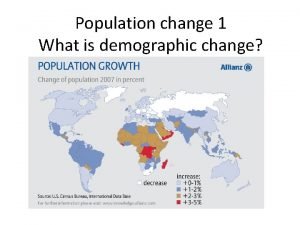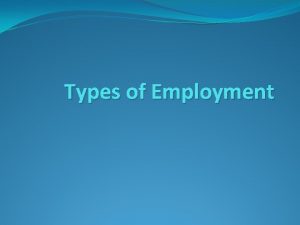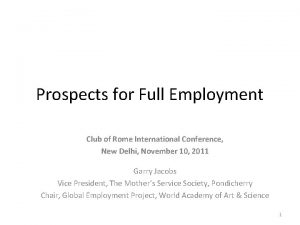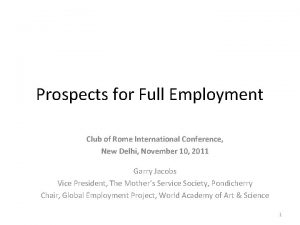Prospects for Full Employment Presented at the UNOGWAAS











- Slides: 11

Prospects for Full Employment Presented at the UNOG-WAAS conference on Opportunities & Challenges of the 21 st Century June 3, 2013 Garry Jacobs Chairman of the Board of Trustees, World Academy of Art & Science Vice President, The Mother’s Service Society, Pondicherry 1

Radical Transformation of Society & Work 1800 2012 Population 1 billion Population 7 billion 3% urban population 49% urban population Life expectancy 29 years Life expectancy 67 years Manual labour Mechanized & automated Land-based People & society-based 85% employed in agriculture 70% of OECD jobs in services World trade 3% of global GDP World trade 27% 2

Population & Employment 1950 -2012 3, 5 9 3 WAP - 208% Population (Billions) 8 Employment 248% 7 2, 5 6 2 5 Population 184% 4 1, 5 3 1 2 0, 5 1 0 1950 1960 Population 1970 1980 1990 Employment 2000 2010 WAP (25 -64) Employment & Working Age Pop. 25 -64 (Billions) 10 0 3

G 20 Working Age Pop 2010 -2020 • Decline in working age population in economically advanced countries will necessitate massive import of workers. • World’s working age population will increase by 440 million by 2020. • India needs to create 30% of those jobs 4

Factors impacting Employment 1. 2. 3. 4. 5. 6. 7. 8. 9. 10. 11. 12. 13. 14. 15. 16. 17. 18. Demography: population growth and increasing life expectancy Rates of economic growth Mechanization and automation Transformation of work: from agriculture to manufacturing to services Globalization of trade and outsourcing International labor mobility Labor policies Public policies and regulation Entrepreneurship Self-employment Virtualization of work Income distribution Patterns of investment – speculative vs. productive Vocational training Higher educational requirements & attainments Freedom and social expectations Social and organizational innovation Legal and social justice 5

Right to Employment: Rationale • Employment is an essential basis for economic security, social stability and psychological well-being. • Human capital is our most productive, creative, precious and perishable resource. • In today’s highly structured society, access to remunerative employment opportunities is the economic equivalent of the right to vote in democracy. • Government that has power to regulate employment also has the responsibility to generate it. • The right to employment is not a privilege, it is a fundamental human right. 6

Right to Employment: Precedents • Bill of Economic Rights, including right to employment, was proposed by US President Roosevelt during WWII. • US Employment Act of 1946 acknowledge the responsibility of national governments for generation of employment. • Universal Declaration of Human Rights (1948) art. 23 & 24 affirm right to work, protection against unemployment, free choice of employment. • ‘International Bill of Human Rights’ (1960 s) on civil, political rights, economic, and social rights. • ILO Declaration of Fundamental Principles & Rights at Work (1998). 7

Sustainable Employment Strategies • • • Redirect surplus to productive investments Human Capital-intensive investment incentives Raise mandatory minimum & tertiary levels of education Vocational Training to closed the “skills gap” Organizational Innovations – e. g. micro credit Internet-based Self-Employment Technological Innovation Complementary currencies tap unutilized resources Job Guarantee Programs – India’s MGREGS Minimum guaranteed income & working hour adjustment Global Norms for Minimum Wage 8

Summary of Conclusions • Pessimism regarding the future of work is neither new nor justified. • Full employment is essential for social stability, economic security and social development • Radical changes in the nature of work necessitate a new theoretical perspective and broader practical approach to the issue of employment. • Full employment can be achieved by comprehensive, integrated strategies based on the perspective of social development as a human process. • It cannot be achieved universally within the present framework and values. • Employment must be recognized as a fundamental human right. • Human-centered theory & policies needed that recognize human welfare as the central purpose & development of human capital as the driving force. • A global model of employment is needed that recognizes the transnational character of both the challenge and the opportunities for full employment. 9

10

Paradox of Unmet Needs & Untapped Social Resources • Unmet needs of 3 billion people living on incomes of less than $2. 50 a day for food, clothes, housing, education, medical care. • World is a-flood with unutilized and underutilized resources. – Daily $4 -5 trillion searches the globe for speculative returns – Since 1980, global financial assets have risen 20 fold, while real incomes grew just 2. 7 fold. – The share of corporate profits and financial investments is rising at the expense of labor. – 200+ million people are unemployed – 40% youth – Billion+ involuntarily underemployed. – Only a fraction of the world’s intellectual, technological and organizational resources harnessed for productive purposes. • This incalculable waste of Human Capital underlines the fallacy 11 of current theory and policies.





















